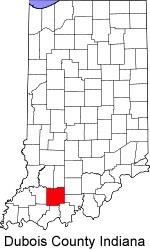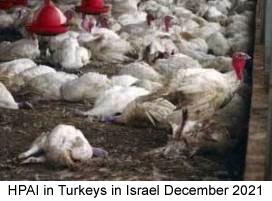 According to a release by the Indiana Board of Animal Health, highly pathogenic avian influenza (HPAI) was diagnosed in a flock of 29,000 18-week growing toms on a farm in Dubois County, IN. According to the report, samples were obtained from a flock on February 7th in one of four houses on the farm that showed depression, elevated mortality and low water intake. This flock yielded a highly pathogenic H5N1virus. The other three flocks were negative on a presumed rapid immunoassay test but were in all probability incubating the infection. Flocks in all four houses were depleted using foam by February 10th. A control zone with quarantine and surveillance was established in accordance with APHIS protocol and following World Organization of Animal Health (OIE) guidelines. As yet no reports of additional cases have been reported among 17 commercial units sampled or approximately 40 backyard and subsistence farms in the control zone where testing is in progress.
According to a release by the Indiana Board of Animal Health, highly pathogenic avian influenza (HPAI) was diagnosed in a flock of 29,000 18-week growing toms on a farm in Dubois County, IN. According to the report, samples were obtained from a flock on February 7th in one of four houses on the farm that showed depression, elevated mortality and low water intake. This flock yielded a highly pathogenic H5N1virus. The other three flocks were negative on a presumed rapid immunoassay test but were in all probability incubating the infection. Flocks in all four houses were depleted using foam by February 10th. A control zone with quarantine and surveillance was established in accordance with APHIS protocol and following World Organization of Animal Health (OIE) guidelines. As yet no reports of additional cases have been reported among 17 commercial units sampled or approximately 40 backyard and subsistence farms in the control zone where testing is in progress.
At best this outbreak will follow the pattern of the January 2016 episode in the same County involving H7N8 that was confined to a few flocks of turkeys under common management.
There is no comment from the State Veterinarian on the possible origin of infection or the nature of the break in biosecurity allowing introduction of the infection. This will hopefully be reviewed in a subsequent epidemiological investigation when the extent of infection is determined. The age of the flocks suggests feed deliveries within recent days and follow up surveillance is indicated beyond the control zone.
 EGG-NEWS has reported on the prevalence of H5N1 AI in migratory waterfowl in the Atlantic Flyway as detected by APHIS surveillance. In recent Webinars commentators have noted that their efforts in 2022 have been concentrated on the Pacific and Atlantic Flyways. Now sampling of hunter-killed birds in the Mississippi and Central Flyways has commenced. Genomic analysis of the H5N1 isolates from the current case in Indiana and isolates from Canada and the Carolinas should indicate whether there is any commonality as a predictor of future outbreaks with a strain expressing a Eurasian genome. This situation would suggest westward movement of free-living birds from the Atlantic flyway. Alternatively the virus may have been transmitted directly or indirectly from the Eastern seaboard by movement of personnel or fomites. The eventual epidemiologic study will be important in determining the pattern of introduction and dissemination of HPAI with special emphasis on turkey production. This segment of the commercial poultry industry appears to be affected in the early stage of a number of HPAI epornitics that have occurred worldwide over the past decade.
EGG-NEWS has reported on the prevalence of H5N1 AI in migratory waterfowl in the Atlantic Flyway as detected by APHIS surveillance. In recent Webinars commentators have noted that their efforts in 2022 have been concentrated on the Pacific and Atlantic Flyways. Now sampling of hunter-killed birds in the Mississippi and Central Flyways has commenced. Genomic analysis of the H5N1 isolates from the current case in Indiana and isolates from Canada and the Carolinas should indicate whether there is any commonality as a predictor of future outbreaks with a strain expressing a Eurasian genome. This situation would suggest westward movement of free-living birds from the Atlantic flyway. Alternatively the virus may have been transmitted directly or indirectly from the Eastern seaboard by movement of personnel or fomites. The eventual epidemiologic study will be important in determining the pattern of introduction and dissemination of HPAI with special emphasis on turkey production. This segment of the commercial poultry industry appears to be affected in the early stage of a number of HPAI epornitics that have occurred worldwide over the past decade.
The trade implications of the Indiana outbreak have yet to be determined but it is hoped that importing nations will respect regionalization in accordance with OIE protocols and with bilateral agreements with the U.S.